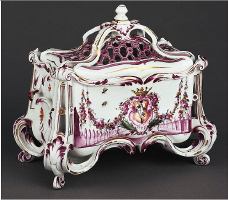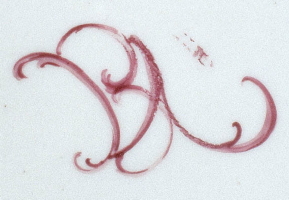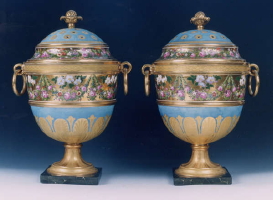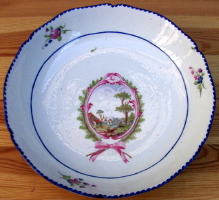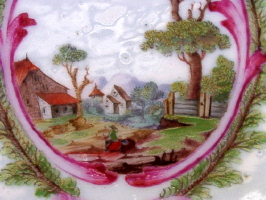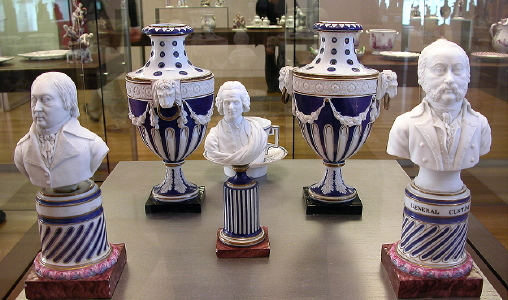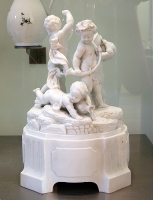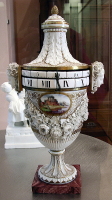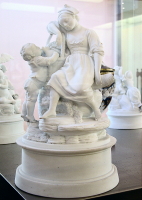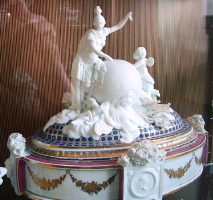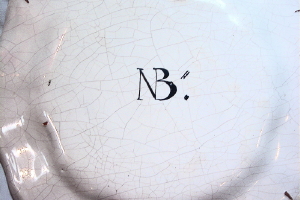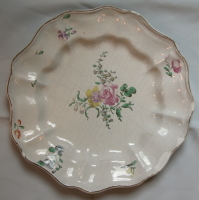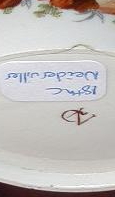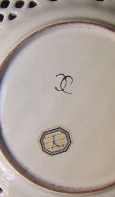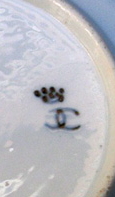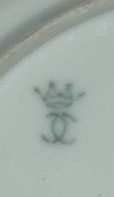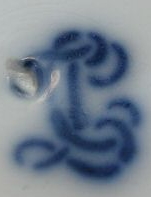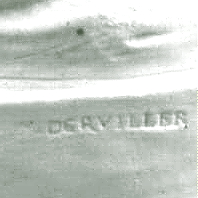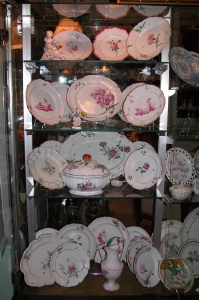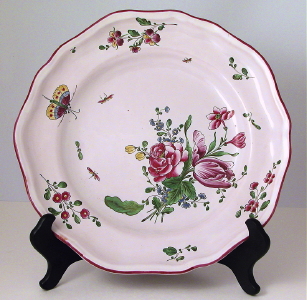18th - early 19th Century
NIDERVILLER PORCELAIN
Manufacture
of hard paste porcelain was begun in 1765 at Niderviller by Baron
Beyerle.
The porcelain enterprise grew out of the faience works.
Kaolin was brought from Germany until
Baron de Beyerle bought some of the first kaolin mines at St. Yrieix.
Period
of Baron de Beyerle
1748 - 1773
Click
image to enlarge.
Bulb
Pot 1768, J. Paul Getty Museum
|
In
the mid-1700s, porcelain became so popular among the nobility
that aristocrats began sponsoring their own manufactories. Jean-Louis
Beyerlé, an advisor to the king, founded one such operation
at Niderviller in 1748, developing it out of an earlier faience-making
business. The new enterprise initially drew its workers and
stylistic inspiration from a neighboring concern in Strasbourg,
which produced ceramic wares in the Rococo taste. At Niderviller,
the workers modified the bright Strasbourg palette, making it
softer.
Because of its unique location in the duchy of Lorraine—where
it was exempt from French laws designed to protect the royal
monopoly of the Sèvres porcelain manufactory—Niderviller flourished
for nearly twenty years, unlike other French porcelain manufactories.
When the Duke of Lorraine died in 1766, the territory reverted
back to the French crown, and the manufactory was then subject
to new, even tighter restrictions on production and decoration.
In 1772 Beyerlé sold the factory to Count Custine. (Getty Museum)
|
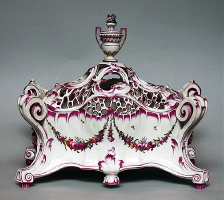 |
Click
image to enlarge.
‘Caisse à Oignons’ (Onion Box), 1761-66, Private Collection
(These
were made in faience and in porcelain.)
Period
of Count de Custine
1773 - 1793
Click
image to enlarge.
1780, Private Collection
Click
images to enlarge.
1792 - 1793, Private Collection
Click
image to enlarge.
Vases
(back row) c. 1780 - 1793
Bust of Custine (left front) c. 1800 - 1820
Musée
du Pays Sarrebourg
Period
of Claude François Lanfrey
1793
- 1827
With
Lanfrey, the manufacture of the porcelain continues in Niderviller.
The moulds of Cyfflé, of use in the 18th century, are still used for
these porcelain biscuits,
which were exported as far as Holland and on the edges of the Rhine.
But his heirs will not be able to repurchase the kaolin that Lanfrey
had close to Saint-Yrieix.
And about 1830, the manufacture of the porcelain is abandoned.
Click
images to enlarge.
1800
- 1827,
Musée du Pays Sarrebourg
This
last piece is one of the monumental pieces of Niderviller
exhibited at the National Museum of Ceramics at Sevres.
Click
images to enlarge.
Garniture
1770-1800, National Ceramics Museum, Sevres
The Niderviller factory was subject to the influence from the Paris
region during the period of Custine-Lanfrey.
The quality of tableware was often variable, but for the larger decorative
items, such as this one,
the factory aimed for high perfection. The designs were often inspired
by forms of silverware and antique marble ornaments from celebrated
collections, eg. Duc d'Aumont.
As
the 19th century marched on, the Niderviller faience factory began
using
the new mass-production techniques of the Industrial Revolution.
Competition with Limoges led to an end of Niderviller porcelain production
at the end of 1830.
Thereafter its production was primarily utilitarian.
Despite a series of bankruptcies and numerous changes in ownership
in the interim,
the factory is still in production today.
Identifying
Marks
There
were no regular identifying marks during the years of Baron de Beyerle's
ownership,
although a "B" or "A and N" interlaced, and impressed in the paste,
were sometimes used.
The Beyerle mark on the plate below is one I saw at Monsieur Bastian's
shop.
Click
images to enlarge.
Under the Comte de Custine, the first regular mark was a monogram
with the letters C and N interlaced.
Later it appeared as two C's crossed beneath a count's coronet.
Beginning in 1792 the mark became "N", or the words "Nider" or "Niderviller"
in underglaze blue.
During
the period of factory Director Lanfrey the mark was C.F.L. ( the initials
for Claude François Lanfrey)
interlaced, in underglaze blue.
When the biscuit pieces and statuettes were marked, it was usually
with "Niderviller" impressed.
( On-line Ref. Old and Sold Antiques)
I have also seen figures and other pieces with just the crossed Cs.
Niderviller
Faience
Collection Bastian
Click
image to enlarge.
A couple of Treasures from my trip
Click
image to enlarge.
1765 - 1770
Shown
above is a very nice 12-inch Niderviller charger, in fleurs fines,
from the Beyerle period,
which I brought back from my trip. It has since sold.
Click
image to enlarge.
Shown
above is a later 18th century, 12-inch, faience charger from Luneville,
a town near Patrick's home, which I purchased from him.
A spectacular example!
It has also sold.
We bid a fond, but sad farewell
to Patrick at Sarrebourg
and made a brief return
to Strasbourg
before we left France...
Return to Index
Click here
